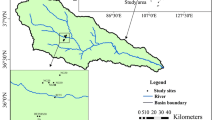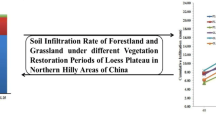Abstract
To improve the ecological environment in China, the Chinese government implemented a country-wide ecological protection and reforestation project (namely the “Grain for Green Project”) in 1999 to return cultivated land with slopes of 25° or more to perennial vegetation. Vegetation restoration reduces soil erosion mainly by changing the soil physical properties. Different vegetation restoration methods might produce different impacts on soil physical properties. In this study, two vegetation restoration methods (i.e., natural restoration and artificial restoration) were compared on abandoned farmland in the typically hilly and gullied areas of the Loess Plateau of Northwest China. In the natural restoration method, the farmland was abandoned to natural vegetation succession without irrigation, fertilization or other artificial disturbances. In the artificial restoration method, the farmland was planted with black locust (Robinia pseudoacacia L.) and watered and cultivated for the first two years. Three soil physical properties (i.e., soil moisture, bulk density and aggregation) were investigated under the two vegetation restoration methods. The results showed that the soil moisture and soil bulk density were higher under artificial restoration than under natural restoration within the first three years of vegetation restoration. By the fourth year, the soil moisture and soil bulk density were higher under natural restoration than under artificial restoration. For the stability of soil aggregates > 0.25 mm, the soil aggregates in the 0-20 cm soil layer were more stable under artificial restoration than under natural restoration, while the results were the opposite for the 40-60 cm soil layer. Overall, the soil physical properties were continuously improved during the restoration of vegetation on abandoned farmland. In choosing between vegetation restoration methods, natural restoration is preferable to artificial restoration, but artificial intervention is needed during the first three years.




Similar content being viewed by others
References
An SS, Mentler A, Mayer H, Blum WEH (2010) Soil aggregation, aggregate stability, organic carbon and nitrogen in different soil aggregate fractions under forest and shrub vegetation on the Loess Plateau, China. Catena 81:226–233
Bai P, Liu X, Yang T, Li F, Liang K, Hu S (2016) Assessment of the influences of different potential evapotranspiration inputs on the performance of monthly hydrological models under different climatic conditions. J Hydrometeorol 17(8):2259–2271
Bai P, Liu X, Liu C (2017) Improving hydrological simulations by incorporating GRACE data for model calibration. J Hydrol 557:291–304
Cao SX et al (2009) Impact of China’s Grain for Green Project on the landscape of vulnerable arid and semi-arid agricultural regions: a case study in northern Shaanxi Province. J Appl Ecol 46(2):536–543
Chen L, Huang Z, Gong J, Fu B, Huang Y (2007) The effect of land cover/vegetation on soil water dynamic in the hilly area of the loess plateau, China. Catena 70:200–208
Fu BJ, Wang YF, Lu YH, He CS, Chen LD, Song CJ (2009) The effects of land-use combinations on soil erosion: a case study in the Loess Plateau of China. Prog Phys Geogr 33(1):793–804
Huang D, Wang K, Wu WL (2007) Dynamics of soil physical and chemical properties and vegetation succession characteristics during grassland desertification under sheep grazing in an agro-pastoral transition zone in Northern China. J Arid Environ 70:120–136
Huang YM, Liu D, An SS (2015) Effects of slope aspect on soil nitrogen and microbial properties in the Chinese Loess region. Catena 125:135–145
Jiao J, Tzanopoulos Xofis, Mitchley J (2008) Factors affecting distribution of vegetation types on abandoned cropland in the hilly-gullied Loess Plateau Region of China. Pedosphere 18:24–33
Kou M et al (2015) Successional Trajectory over 10 years of vegetation restoration of Abandoned Slope croplands in the Hill-Gully Region of the Loess Plateau. Land Degrad Dev 27:1–14
Li P (2016) Groundwater quality in Western China: challenges and paths forward for groundwater quality research in Western China. Expos Health 8:305–310. https://doi.org/10.1007/s12403-016-0210-1
Li YY, Shao MA (2006) Change of soil physical properties under long-term natural vegetation restoration in the Loess Plateau of China. J Arid Environ 64:77–96
Li P, Qian H, Wu J (2011) Hydrochemical formation mechanisms and quality assessment of groundwater with improved TOPSIS method in Pengyang County Northwest China. E-J Chem 8:1164–1173. https://doi.org/10.1155/2011/251918
Li P, Wu J, Hui Q (2012) Groundwater quality assessment based on rough sets attribute reduction and TOPSIS method in a semi-arid area, China. Environ Monit Assess 184:4841–4854. https://doi.org/10.1007/s10661-011-2306-1
Li P, Wu J, Qian H (2013a) Assessment of groundwater quality for irrigation purposes and identification of hydrogeochemical evolution mechanisms in Pengyang County, China. Environ Earth Sci 69:2211–2225. https://doi.org/10.1007/s12665-012-2049-5
Li P, Qian H, Wu J, Zhang Y, Zhang H (2013b) Major ion chemistry of Shallow groundwater in the Dongsheng coalfield, Ordos Basin China. Mine Water Environ 32(3):195–206. https://doi.org/10.1007/s10230-013-0234-8
Li P, Qian H, Wu J (2014a) Accelerate research on land creation. Nature 510(7503):29–31. https://doi.org/10.1038/510029a
Li P, Qian H, Wu J, Chen J, Zhang Y, Zhang H (2014b) Occurrence and hydrogeochemistry of fluoride in alluvial aquifer of Weihe River, China. Environ Earth Sci 71:3133–3145. https://doi.org/10.1007/s12665-013-2691-6
Li P, Tian R, Xue C, Wu J (2017) Progress, opportunities and key fields for groundwater quality research under the impacts of human activities in China with a special focus on western China. Environ Sci Pollut Res 24(15):13224–13234
Liu B, Shao MA (2014) Estimation of soil water storage using temporal stability in four land uses over 10 years on the Loess Plateau, China. J Hydrol 517:974–984
Liu Y, Fu B, Lü Y, Wang Z, Gao G (2012) Hydrological responses and soil erosion potential of abandoned cropland in the Loess Plateau, China. Geomorphology 138:404–414
Liu MY, Chang QR, Qi YB (2014) Aggregation and soil organic carbon fractions under different land uses on the tableland of the Loess Plateau of China. Catena 115(3):19–28
Osman N, Barakbah SS (2011) The effect of plant succession on slope stability. Ecol Eng 37:139–147
Radford BJ, Yule DF, Braunack M, Playford C (2008) Effects of grazing sorghum stubble on soil physical properties and subsequent crop performance. Am J Agr Biol Sci 3(4):734–742
Wang Y, Fu B, Lü Y, Chen L (2011) Effects of vegetation restoration on soil organic carbon sequestration at multiple scales in semi-arid Loess Plateau, China. Catena 85:58–66
Wang L, Mu Y, Zhang QF, Jia ZK (2012) Effects of vegetation restoration on soil physical properties in the wind-water erosion region of the Northern Loess Plateau of China. Clean–Soil Air, Water 40:7–15
Wang S, Fu B, Gao G, Liu Y, Zhou J (2013) Responses of soil moisture in different land cover types to rainfall events in a re-vegetation catchment area of the Loess Plateau, China. Catena 101:122–128
Wu J, Li P, Qian H, Fang Y (2014) Assessment of soil salinization based on a low-cost method and its influencing factors in a semi-arid agricultural area, northwest China. Environ Earth Sci 71(8):3465–3475. https://doi.org/10.1007/s12665-013-2736-x
Xiao L, Xue S, Liu G, Zhang C (2014) Soil moisture variability under different land uses in the Zhifanggou catchment of the Loess Plateau, China. Arid Land Res Manag 28:274–290
Yao S, Qin J, Peng X, Zhang B (2009) The effects of vegetation on restoration of physical stability of a severely degraded soil in China. Ecol Eng 35:723–734
Zhang C, Xue S, Liu GB, Song ZL (2011) A comparison of soil qualities of different revegetation types in the Loess Plateau, China. Plant Soil 347:163–178
Zhang C, Liu G, Xue S, Zhang C (2012) Rhizosphere soil microbial properties on abandoned croplands in the Loess Plateau, China during vegetation succession European. J Soil Biol 50:127–136
Zhang X, Zhao W, Liu Y, Fang X, Feng Q, Chen Z (2017) Spatial variations and impact factors of soil water content in typical natural and artificial grasslands: a case study in the Loess Plateau of China. J Soils Sedim 17:1–15
Zhao D, Xu M, Liu G, Ma L, Zhang S, Xiao T, Peng G (2017) Effect of vegetation type on microstructure of soil aggregates on the Loess Plateau, China. Agr Ecosyst Environ 242:1–8
Zheng FL (2006) Effect of Vegetation Changes on Soil Erosion on the Loess Plateau. Pedosphere 16:420–427
Zhou ZC, Gan ZT, Shangguan ZP, Dong ZB (2010) Effects of grazing on soil physical properties and soil erodibility in semiarid grassland of the Northern Loess Plateau (China). Catena 82:87–91
Zhou J, Fu B, Gao G, Lü Y, Liu Y, Nan L, Wang S (2016) Effects of precipitation and restoration vegetation on soil erosion in a semi-arid environment in the Loess Plateau, China. Catena 137:1–11
Zhu TX (2012) Gully and tunnel erosion in the hilly Loess Plateau region, China. Geomorphology s 153–154:144–155
Acknowledgements
This research was supported by the National Natural Science Foundation of China project titled “The quantified method of vegetation distribution in watershed and its effect on soil and water loss on Loess Plateau” (No. 51609196).
Author information
Authors and Affiliations
Corresponding author
Additional information
This article is a part of a Topical Collection in Environmental Earth Sciences on Water resources development and protection in loess areas of the world, edited by Drs. Peiyue Li and Hui Qian.
Rights and permissions
About this article
Cite this article
Li, J., Li, Z., Guo, M. et al. Effects of vegetation restoration on soil physical properties of abandoned farmland on the Loess Plateau, China. Environ Earth Sci 77, 205 (2018). https://doi.org/10.1007/s12665-018-7385-7
Received:
Accepted:
Published:
DOI: https://doi.org/10.1007/s12665-018-7385-7




